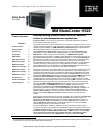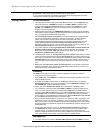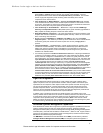
Workhorse 2-socket single- or dual-core Intel Xeon blade server
Please see the Legal Information section for important notices and information.
6.
BladeCenter Chassis
IBM offers three choices of chassis in which to use the HS20 blade server. Each chassis serves
different customer needs. The original BladeCenter chassis offers maximum density, great
flexibility and a wide variety of expansion options at an entry-level price. The next-generation
BladeCenter H chassis offers all of BladeCenter’s capabilities, and adds new high-performance
features. For those customers in need of a ruggedized chassis (for example, government/
military or telcos), BladeCenter T offers special features optimized for those environments.
There is a high degree of interchangeability and compatibility of features among the three
chassis. Any or all of these chassis can be installed in a rack along with other rack-optimized
equipment.
BladeCenter is a 7U chassis that provides:
• Reduced single points of failure — Many major components (either standard or optionally)
are hot-swappable and/or redundant. Servers and modules can be configured for
automatic failover to backups.
• Forward and backward compatibility — Every blade (but one) and every switch and
passthru module released by IBM for BladeCenter since 2002 is supported. New blades and
fabric switches released by IBM for BladeCenter H or BladeCenter T will also be supported in
the original BladeCenter chassis for the foreseeable future.
• Fourteen 30mm blade slots — These hot-swap slots are capable of supporting up to 14
HS20 or HS21 (Xeon), LS20 (AMD
®
Opteron
®
), and JS20/JS21 (IBM PowerPC 970FX/MP)
blade servers, or 7 double-wide (60mm) HS40 blade servers or a mixture of 30mm and
60mm blades. It also supports 30mm optional Storage and I/O Expansion Units, Memory
and I/O Expansion Units (for HS21), and/or PCI I/O Expansion Unit IIs in combination with
the blade servers, using the same blade slots. Up to six chassis can be installed in an
industry-standard 42U rack, for a total of up to 84 30mm blade servers per rack, with full
power redundancy.
• Four module slots for communication and I/O switches — The modules interface with all
of the blade servers in the chassis and eliminate the need for external switches or expensive,
cumbersome cabling. All connections are done internally via the midplane. Two module slots
are reserved for hot-swap/redundant Gigabit Ethernet switch modules. The other two bays
support additional Gigabit Ethernet modules, or Fibre Channel, InfiniBand, and other switch
modules or pass-through devices. All modules, when installed in pairs, offer load balancing
and failover support. Integrated switch modules mean that no extra rack “U space” is
required.
• Two module bays for management modules (IBM BladeCenter Management Module or
the new Advanced Management Module, depending on the model of the BladeCenter
chassis) — The management module provides advanced systems management and KVM
capabilities for not only the chassis itself, but for all of the blades and other modules installed
in the chassis. The Management Module provides capabilities similar to the IBM Remote
Supervisor Adapter II used in stand-alone IBM System x
™
or IBM eServer
™
xSeries
®
rack
and tower servers. The features of the Management Module can be accessed either locally
or remotely across a network. One module comes standard. A second Management Module
can be added for hot-swap/redundancy and failover.
• Four module bays for Blower Modules — Two hot-swap/redundant blower modules come
standard with the chassis. They are capable of providing efficient cooling for up to 7 blades.
These modules replace the need for each blade to contain its own fans. The two blowers are
more energy efficient than dozens or hundreds of smaller fans would be, and they offer many
fewer points of potential failure. Two additional blower modules can be installed when more
than 7 blades are used in a chassis.
• Four module bays for Power Modules — BladeCenter ships with two 2000W high-
efficiency hot-swap/redundant power modules (upgradeable to four), capable of handling
the power needs of the entire chassis. Many servers use power supplies with an efficiency
level of approximately 65-75%. Because BladeCenter uses power supplies that are at least
90% efficient, much less power is wasted as heat. Not only is more power available for
chassis use, there is less power wasted as excess heat output.
• Redundant Midplane connections — By giving each blade two physical connections to the
midplane that connects all blades and modules together internally, a failure of one connector
cannot bring down the server.
• A hot-swappable Media Tray containing a DVD-ROM drive, a floppy drive, one USB 1.1
port, and a light path diagnostic panel — The media tray is shared by all the blades in the
server. This eliminates unnecessary parts (and reduces the number of parts than can fail). In
the event of a failure of the Media Tray the tray can be swapped for another. While the tray is
offline, the servers in the chassis can remotely access the Media Tray in another chassis.
The light path diagnostic panel contains LEDs that identify which internal components are in
need of service.


















